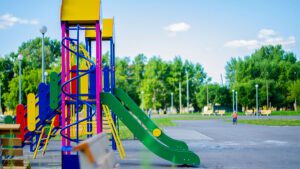Investing in commercial playground equipment often prompts sticker shock. Many decision-makers—school administrators, park planners, church leaders, and childcare operators—wonder: “Why is commercial playground equipment so expensive?” The upfront cost can seem high compared to simple backyard sets, but numerous factors contribute to the final price. Understanding these elements can help you appreciate the value, ensure budget planning, and choose equipment that offers safety, durability, and long-term savings.
In this comprehensive guide, we’ll break down the key cost drivers behind commercial playground equipment. We will explore raw materials, specialized hardware, engineering and design, manufacturing overhead, safety testing, insurance, warranties, logistics, and additional factors. We’ll also discuss the return on investment (ROI) and strategies to make informed purchasing decisions. By the end, you’ll see why the seemingly steep price tag often represents an affordable, long-lasting investment.

1. Premium Raw Materials
1.1 Steel: The Backbone of Durability
- Volume and Quality: A typical commercial playground contains as much steel as a luxury sedan. However, unlike mass-market automotive steel, playground steel must meet stringent ASTM (American Society for Testing and Materials) guidelines. This requires premium-grade steel with precise specifications for strength and safety.
- Galvanization & Coatings: To withstand constant outdoor exposure—rain, UV rays, temperature changes—the steel undergoes galvanization (zinc coating) and often powder-coating or specialized paint. Galvanization prevents rust; powder-coats add UV resistance and aesthetic color options. These treatments add cost in materials and processing.
- Market Fluctuations: Steel prices fluctuate based on global demand, tariffs, and raw material availability. Playground manufacturers must absorb or pass along these market-driven changes, which can cause final equipment costs to vary year to year.
1.2 Specialized Plastics & Composites
- UV-Stabilized Plastics: Slides, panels, roofs, and tunnels often use rotomolded or injection-molded high-density polyethylene (HDPE) or similar plastics. Unlike consumer-grade plastics, these formulations include UV stabilizers to resist fading, brittleness, or cracking over decades. The raw resin cost is higher than standard plastics.
- Large Molds & Roto-Molding: Producing sizeable curved slides or panels demands custom molds and expensive rotomolding machinery. Tooling costs amortize over production runs, but initial investment is high. Low-volume runs (for unique designs) further increase per-unit mold costs.
- Composite & Specialty Materials: Some modern playground features incorporate composite materials (e.g., fiberglass-reinforced panels) or engineered woods for aesthetic appeal and durability, adding additional material expense.
1.3 Premium Hardware and Fasteners
- Tamper-Proof, High-Grade Fasteners: Commercial playgrounds use hundreds to thousands of nuts, bolts, washers, and screws made from tempered, corrosion-resistant steel, often with tamper-proof heads to prevent loosening or unauthorized adjustments. Consumer hardware stores rarely stock these high-spec fasteners, and purchasing them in bulk directly from industrial suppliers incurs higher costs (e.g., $1+ per piece).
- Special Washers & Locking Mechanisms: Additional components like lock washers, nylon inserts, or threadlock compounds ensure long-term stability and safety but add manufacturing overhead.

2. Design, Engineering & Overhead
2.1 Professional Playground Design
- Certified Designers & Engineers: Before manufacturing begins, playgrounds are conceived by experienced designers. They create 3D models, plan layouts for accessibility (ADA compliance), traffic flow, and age-appropriate zones. Each design undergoes review by structural engineers who verify load capacities, wind resistance, and structural integrity.
- Custom vs. Pre-Designed Kits: Off-the-shelf playground designs spread engineering costs over many units. However, many clients request custom themes, sizes, or site-specific adaptations. Customization increases design hours, engineering reviews, and often additional safety analyses.
2.2 Safety Standards & Compliance
- ASTM & CPSC Guidelines: Commercial equipment must comply with ASTM F1487 (Standard Consumer Safety Performance Specification for Playground Equipment for Public Use) and CPSC (Consumer Product Safety Commission) recommendations. Ensuring compliance involves detailed design documentation, certified testing procedures, and regular updates as standards evolve.
- Accessibility (ADA) Requirements: To serve all children—including those with disabilities—designs must incorporate accessible routes, inclusive play elements, and compliant surfacing. ADA compliance may require ramps, transfer stations, and specialized equipment, adding to the complexity and cost of design and materials.
2.3 Manufacturing Overhead
- Large Facilities & Equipment: Building sizable steel structures and plastic components requires expansive manufacturing plants. These facilities house cutting, bending, welding stations, rotomolding ovens, painting booths, and assembly areas. The overhead of running heavy machinery, climate control, lighting, and safety systems is significant.
- Labor Costs & Expertise: Skilled labor is essential: welders, machinists, plastic technicians, painters, quality inspectors, and packaging teams. In addition, corporate overhead includes engineers, designers, sales teams, customer support, accounting, and HR. These personnel costs reflect in equipment pricing.
- Inventory & Raw Material Storage: Manufacturers must stock large quantities of steel tubing, plastic resins, hardware, and coatings. Warehousing space and inventory management systems tie up capital and incur ongoing costs.

3. Safety Testing, Certification & Liability
3.1 Third-Party Testing & Certification
- IPEMA Certification: Many manufacturers obtain IPEMA (International Play Equipment Manufacturers Association) certification to validate compliance with ASTM and CPSC standards. Third-party testing involves physical tests: structural load testing, impact attenuation tests (with certified surfacing), and durability assessments. These services are not free; laboratories charge per test series, which adds to production expenses.
- Routine Quality Audits: Beyond initial certification, periodic audits ensure consistency across production batches. Minor design tweaks or material supplier changes may trigger retesting.
3.2 Insurance & Liability Costs
- High Insurance Premiums: Playground manufacturers and installers face elevated liability insurance costs because the end users—children—are vulnerable to injury. Insurance underwriters consider potential claims payouts, leading to substantial annual premiums. Businesses pass part of this cost to customers to maintain financial viability.
- Legal Safeguards & Documentation: Manufacturers maintain comprehensive documentation—engineering reports, test certificates, maintenance manuals, and warning labels—to mitigate legal risks. Producing and updating these documents requires legal and technical staff involvement.
3.3 Warranties & After-Sales Support
- Lifetime or Multi-Year Warranties: Many reputable commercial playground companies offer long-term warranties on steel structures, coatings, and plastic components. Honoring warranties means planning for replacement parts, technical support, and potential site visits, which represent ongoing expense.
- Maintenance Guidelines & Service Plans: To uphold warranties and safety, manufacturers provide detailed maintenance schedules—regular inspections, tightening hardware, resurfacing recommendations—that clients may purchase as service plans. Developing these programs entails additional administrative costs.

4. Logistics & Installation
4.1 Shipping & Transportation
- Bulk & Oversized Components: Playground equipment often ships as large crates or flat-packed steel sections, plastic slides, and hardware kits. Freight costs depend on weight, volume, and distance from the manufacturing plant to the installation site. Fuel price fluctuations and specialized handling (e.g., forklifts, lift gates) add variability to shipping costs.
- Custom Packaging: To protect components during transit—especially plastic slides and coated steel—manufacturers use custom crating, protective films, and cushioning materials. This specialized packaging increases material and labor costs.
4.2 Professional Installation
- Certified Installers: Proper installation is critical for safety. Manufacturers or authorized contractors employ trained installers who follow precise instructions, use proper anchoring methods (e.g., concrete footings), and verify structural alignment. Labor rates for skilled installers add to the overall project cost.
- Site Preparation: Before equipment assembly, sites require grading, drainage planning, and surfacing installation (e.g., engineered wood fiber, rubber mulch, or poured-in-place rubber). Coordinating site prep contractors and scheduling can increase project complexity and expense.
- Inspection & Sign-Off: Post-installation, a final safety inspection—often conducted by third parties or local authorities—confirms compliance. Any required adjustments or corrections incur additional labor.

5. Long-Term Value & Return on Investment (ROI)
5.1 Durability & Lifespan
- Longevity vs. Short-Term Savings: Cheap, non-commercial playground equipment may cost less initially but often weathers poorly—fading plastics, rusting steel, broken components—leading to frequent repairs or replacements. In contrast, premium commercial-grade equipment can last decades with minimal upkeep when properly maintained, making the lifetime cost more economical.
- Reduced Maintenance Costs Over Time: While initial investment is higher, robust materials and coatings reduce annual maintenance expenses (painting, part replacements), lowering total cost of ownership.
5.2 Safety & Liability Mitigation
- Fewer Injuries & Liability Claims: Well-designed, tested, and professionally installed equipment minimizes injury risks. Fewer accidents translate to lower liability exposure and insurance claims for property owners (schools, municipalities), which in turn can lower insurance premiums over time.
- Peace of Mind for Stakeholders: Administrators and parents appreciate safe play environments that meet recognized standards, boosting community trust and support.
5.3 Community & Marketing Benefits
- Attracting Families & Visitors: A high-quality playground can become a focal point for families, drawing more visitors to parks, schools, or commercial areas. Increased foot traffic benefits adjacent amenities (cafés, retail) and can justify public or private investment.
- Positive Public Perception: Investing in safe, durable playgrounds signals commitment to community well-being, enhancing reputation for schools, municipalities, or businesses. This reputational value can’t always be quantified but contributes to overall ROI.
5.4 Resale & Component Reuse
- Modular Components: Some commercial playground systems use modular designs allowing components to be reconfigured or repurposed. If a park redesign occurs, sections of existing equipment can be moved to another location, preserving some value.
- Secondary Market: Well-maintained commercial equipment sometimes has resale or trade-in value, offsetting the cost of upgrades.

6. Making Informed Purchasing Decisions
6.1 Budget Planning & Phased Implementation
- Site Assessment & Prioritization: Begin with a thorough assessment: user age groups, site size, accessibility needs, and desired play themes. Prioritize must-have safety elements and core play structures first; consider adding supplementary features (shade canopies, musical panels) in later phases as budget permits.
- Phased Rollouts: If budget constraints exist, plan a multi-year rollout: install primary play structure initially and add features (e.g., swings, fitness stations) in subsequent budgets. This spreads costs while still delivering tangible improvements early.
6.2 Comparing Quotes & Value Analysis
- Detailed Proposals: Request itemized quotes that break down costs for equipment, site prep, installation, surfacing, shipping, and maintenance plans. This transparency helps identify where costs lie and opportunities for adjustments (e.g., choosing different surfacing or scaling back certain features).
- Total Cost of Ownership (TCO): Evaluate not only initial purchase but also ongoing maintenance, expected lifespan, and potential replacement costs. A cheaper supplier might require more frequent part replacements or lack robust warranties, increasing TCO.
- Vendor Reputation & Support: Consider manufacturers with proven track records, positive customer testimonials, and reliable after-sales support. A small price saving from an untested vendor can lead to higher long-term costs if support is lacking.
6.3 Grant Funding & Partnerships
- Public Grants & Sponsorships: Many municipalities and non-profits offer grants or matching funds for community play spaces. Seek local business sponsorships (e.g., naming rights for a play zone). Collaborate with parent-teacher associations or civic groups to share funding responsibilities.
- Corporate Partnerships: Some playground manufacturers partner with corporate social responsibility (CSR) initiatives, offering discounts or donated equipment for community projects, which can reduce net costs.
6.4 Maintenance & Training Plans
- Structured Maintenance Contracts: Invest in a maintenance plan from the outset: routine inspections, hardware tightening, surfacing top-ups, and periodic deep-cleaning. A well-maintained playground stays safe and extends lifespan.
- Staff Training & Documentation: Ensure on-site staff or volunteers understand maintenance procedures and can conduct basic inspections. Manufacturers often supply maintenance manuals and checklists—use them regularly to avoid small issues escalating into costly repairs.

7. Case Example: Breaking Down a Hypothetical Playground Budget
To illustrate cost allocation, consider a mid-size community playground with an 8-foot-tall play structure, swings, and surfacing on a 3,000 sq. ft. area. Approximate cost breakdown might be:
- Equipment & Components (50–60%):
- Steel structures, slides, panels, swings, climbers: $60,000
- High-grade plastics & hardware included in equipment cost.
- Design & Engineering (5–10%):
- Site-specific layout, ADA compliance review, structural engineering: $8,000
- Surfacing (10–15%):
- Engineered wood fiber or poured-in-place rubber for 3,000 sq. ft.: $15,000
- Installation & Labor (10–15%):
- Certified installers, anchoring, assembly labor: $12,000
- Shipping & Logistics (5–10%):
- Freight for large steel and plastic components to site: $8,000
- Safety Testing & Certification (2–3%):
- Third-party IPEMA testing, site inspection: $3,000
- Insurance & Permits (2–3%):
- Manufacturer liability insurance embedded in price; local permits and site inspections: $2,000
- Warranties & Aftercare Setup (2%):
- Initial setup for maintenance plan, training materials: $2,000
Total Estimated Project Cost: ~$110,000
While the headline figure may feel high, note the extensive services and safeguards included: premium materials, engineering compliance, surfacing for safety, trained installers, and warranties. Over decades of use, this playground serves thousands of children safely, reducing future repair costs and liability risks.

8. Additional Factors Influencing Cost
8.1 Site-Specific Challenges
- Uneven Terrain or Sloped Sites: Grading or retaining walls may be required, adding earthwork costs.
- Drainage & Stormwater Management: In areas with heavy rainfall, proper drainage systems prevent erosion of surfacing and avoid water pooling.
- Utilities & Amenities: Adding shade structures, seating, drinking fountains, or lighting increases project scope and cost.
8.2 Theming & Aesthetics
- Custom Themes & Branding: Incorporating logos, mascots, or elaborate themes (pirate ships, space motifs) requires custom fabrication of panels and graphics, raising design and production costs.
- Color Choices & Finishes: Certain powder-coat colors or UV-resistant finishes can be more expensive, especially custom-matched shades.
8.3 Seasonal Timing & Lead Times
- Peak Demand Seasons: Ordering playground equipment when manufacturers are busiest may extend lead times; expedited production or off-season ordering can influence pricing or availability.
- Global Supply Chain Factors: Delays in steel or resin deliveries can affect production schedules and potentially incur rush charges.

9. Tips to Mitigate Costs Without Sacrificing Quality
- Plan Early & Bundle Services: Early planning allows time for competitive bidding on site prep, surfacing, and installation. Bundling multiple services with one provider may yield discounts.
- Phased Approach: Install core play structure first; add swings, fitness stations, or cafes later when additional funds become available.
- Standardized Designs: Select from a manufacturer’s proven, pre-engineered modules rather than fully custom designs to spread engineering costs across multiple clients.
- Grants & Community Fundraising: Leverage local grants, community fundraising events, or corporate sponsorships to offset costs.
- Maintenance Investments: A modest annual maintenance budget (e.g., cleaning, hardware checks) prevents small issues from escalating, preserving long-term value.
- Sustainable Surfacing Choices: Engineered wood fiber often costs less initially than poured rubber, yet meets safety standards. Evaluate lifecycle costs to choose the best surfacing for your budget.
10. Conclusion
Commercial playground equipment may appear expensive upfront, but its cost reflects rigorous standards, premium materials, expert design, extensive testing, liability coverage, and long-term support. Far from an indulgence, it represents a sound investment in children’s safety, community well-being, and long-lasting value. When planned and executed thoughtfully—leveraging grants, staged implementation, and proven manufacturers—high-quality playgrounds become affordable, durable assets that serve generations.
Key Takeaways:
- Premium Materials & Processes: ASTM-compliant steel, UV-stable plastics, tamper-proof hardware, galvanization, and specialized coatings drive material costs.
- Design & Engineering: Certified playground designers and structural engineers ensure safety, accessibility, and durability, especially for custom or themed projects.
- Manufacturing Overhead: Large facilities, skilled labor, inventory storage, and quality control add to production expenses.
- Safety Testing & Liability: Third-party certification (e.g., IPEMA), high insurance premiums, and long-term warranties are essential but costly.
- Logistics & Installation: Freight for bulky items, professional installers, site prep, surfacing, and final inspections contribute to the overall budget.
- Long-Term Value: Durable equipment reduces future repair costs, mitigates liability risks, and provides community benefits—yielding strong ROI.
- Cost-Reduction Strategies: Early planning, phased rollouts, standard designs, community partnerships, and proper maintenance can make projects more budget-friendly without compromising safety or quality.
If you’re planning a new playground or upgrading an existing one, request detailed, itemized quotes from reputable commercial playground manufacturers. Compare total cost of ownership, warranties, maintenance plans, and community impact. By appreciating the factors behind pricing, you can make informed decisions and secure a play environment that is both safe and cost-effective over its lifespan.




